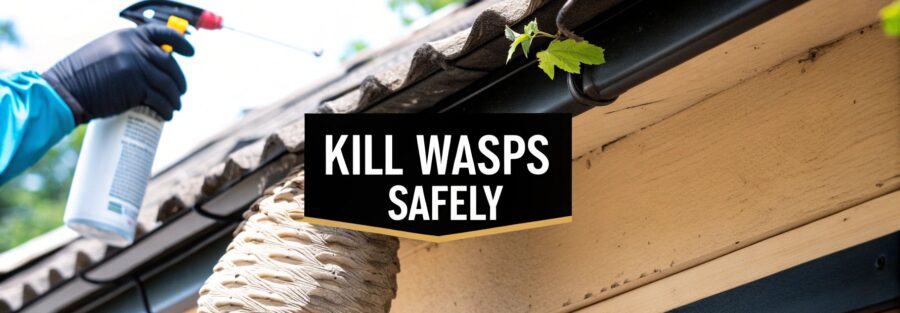Before you even think about how to kill a wasp, you need to understand why you're doing it and what you're up against. Grabbing a can of wasp killer spray is one thing, but knowing when to use it—and when to walk away—is the key. Wasps, especially late in the summer, are notoriously aggressive, and a poorly timed swat can turn a minor problem into a painful one.
Knowing When and Why to Take Action on Wasps

So, you’ve spotted a wasp. Before you declare war, take a breath and assess the situation. Is it a single, disoriented wasp that’s found its way inside through an open window? That’s a nuisance. Is it a steady stream of them disappearing into a crack in your eaves? That’s a sign of a much bigger, hidden threat.
Your best tool isn't a spray can or a fly swatter; it's understanding wasp behaviour.
The Wasp Colony Life Cycle
The common wasps we see in the UK (Vespula vulgaris and Vespula germanica) have a fascinating, and frankly quite formidable, annual cycle. It all starts in spring with a single queen emerging from hibernation. She builds a tiny, golf-ball-sized nest and lays her first eggs.
Once these initial worker wasps mature, the colony's growth explodes. By the height of summer, that small starter nest can be home to thousands of wasps.
This is when things get tricky. Late summer is peak "angry wasp" season. The colony’s natural food sources are drying up, so the workers get desperate for sugary foods and drinks – which is why they suddenly seem obsessed with your picnics and fizzy drinks. Their agitation and sheer numbers lead to far more frequent and dangerous encounters with us.
Your goal isn't just to kill one wasp; it's to understand the potential threat the entire colony represents. A reactive swat can escalate a minor problem into a major one very quickly.
Understanding the Real Health Risks
It’s easy to write off a wasp sting as just a painful annoyance, but the health risks are very real. A disturbed wasp doesn't just sting; it releases alarm pheromones. Think of it as a chemical panic button that tells every other wasp in the vicinity, "Attack!" This is what can trigger a swarm response, leading to multiple stings.
This biological defence is a key reason why official UK health advice from bodies like the BPCA strongly discourages DIY nest removal. For some people, the danger is even greater. Wasp venom can cause severe allergic reactions, including life-threatening anaphylaxis, from just a single sting.
So, before you act, ask yourself these crucial questions:
- Is it just a lone wasp? A single intruder can usually be dealt with using low-risk methods.
- Is there a nest nearby? If you're seeing constant wasp traffic, you're dealing with a colony that needs a proper strategy.
- Are you or anyone in your family allergic? If the answer is yes, the risk is automatically higher. This is when calling in a professional is not just wise, it's essential.
Right, before you even think about tackling a wasp problem, you have to be 100% sure you're actually dealing with wasps. It sounds obvious, but here in the UK, it’s incredibly common for people to mistake them for vital pollinators like bees, or even their bigger cousins, the hornet.
Getting this wrong isn't just a waste of time; it can be dangerous and puts our crucial bee populations at risk.
Take a good, hard look at the insect from a safe distance. Wasps have that classic, unmistakable "cinched" waist and a smooth, almost shiny body with harsh, bright yellow and black stripes. Their flight pattern is aggressive and jerky. Bees, on the other hand, are generally rounder and look fuzzy. They have a much more bumbling, gentle flight as they move between flowers. Hornets are the heavyweights – bigger than wasps, with more brown and deep orange markings mixed in with the yellow.
Wasp Identification Guide: UK Species
It’s easy to get them mixed up when one is buzzing around your head. This quick guide should help you tell the difference between the most common flying insects you'll find in your garden.
| Insect | Appearance | Behaviour | Nest Type |
|---|---|---|---|
| Common Wasp | Bright yellow & black stripes, smooth body, defined waist. | Aggressive, especially in late summer. Scavenges for food. | Grey, papery, ball-shaped. Found in lofts, sheds, wall cavities, or underground. |
| Hornet | Larger than a wasp. Yellow, brown, and orange markings. | Less aggressive than wasps unless provoked. Loud, low-pitched buzz. | Papery, similar to a wasp nest but usually browner. Often in hollow trees or voids. |
| Honeybee | Golden-brown and black, fuzzy appearance, stout body. | Generally docile. Will only sting once as a last resort to defend the hive. | Wax combs, typically hidden in cavities like chimneys or hollow walls. |
| Bumblebee | Large, round, and very fuzzy. Black with yellow/white/orange bands. | Very placid and non-aggressive. A 'bumbling' flight pattern. | Small, messy nests, often in compost heaps, under sheds, or in bird boxes. |
Correctly identifying the insect is the first step. If you’ve got bees, especially honeybees, the approach is completely different and often involves contacting a local beekeeper for safe relocation.
Pinpointing the Nest Location
Once you've confirmed it's wasps, the real detective work begins: finding their headquarters. The nest is the source of your problem, and where it's located will dictate your entire plan of attack.
Don't just look up in the eaves. Wasps are surprisingly creative builders.
The best way to find a nest is to watch the wasps from a safe spot. You'll soon notice a consistent flight path – a sort of "wasp motorway" with insects flying back and forth to a single point. Follow that line of traffic, and it will lead you straight to their front door.
Common places to find a wasp nest in the UK include:
- Lofts and attics: The perfect dark, quiet, and undisturbed real estate for a growing colony.
- Sheds and outbuildings: Wooden sheds are full of gaps and sheltered corners wasps love.
- Wall cavities: A tiny hole in your brickwork can be the entrance to a huge nest hidden inside.
- Underground: Some species, like the German wasp, happily build nests in old rodent burrows or at the bottom of a compost heap.
The most definitive sign, of course, is the nest itself. Wasp nests are made from chewed wood pulp mixed with saliva, which creates a distinctive papery, swirling grey or beige structure. It looks a lot like papier-mâché. If you find one of these, you have an active colony.
Why Nest Size and Location Are So Critical
It’s a classic mistake to underestimate a wasp nest. A queen starts building it on her own in spring, but as soon as her first workers hatch, the colony's growth explodes. A small nest in May can swell to house up to 10,000 wasps by the time August rolls around, turning a minor nuisance into a major hazard. To get a better sense of this timeline, you can explore the details of the wasp life cycle.
A nest's location is just as important as its size. A visible nest hanging from a beam in your shed is one thing, but a nest hidden deep inside a wall cavity or perched three storeys up on your roofline is a completely different beast. The first might seem like a straightforward job, but the second is strictly for professionals.
Trying to treat an inaccessible nest yourself is a recipe for disaster. More often than not, it just ends with thousands of angry wasps finding a new way out – right into your living room.
How to Handle a Single Wasp Indoors

It’s a familiar scene: a lone wasp buzzing frantically against a window pane or circling a light fitting. The immediate urge is to grab the nearest magazine and start swatting, but that’s often the worst thing you can do.
This isn't an invasion; it's usually just one lost worker wasp that has blundered its way inside. Panic and aggression will only escalate the situation. When you crush a wasp, it can release alarm pheromones. While it's unlikely to summon a swarm from outside, swatting it wildly just increases your chances of getting stung in the process. A calm, controlled approach is always the best bet.
Using Commercial Wasp Killer Sprays
For a quick and decisive solution, a dedicated wasp and hornet killer spray is hard to beat. These aerosols are designed to fire a direct jet of insecticide from a safe distance, which is perfect when you're dealing with one indoors.
If you're going this route, here's how to do it properly:
- First, make sure any people or pets are out of the room.
- Aim the spray directly at the wasp and give it a short, sharp burst.
- Once it's down, it's a good idea to leave the room for a bit and let it air out before you go back in to clean up.
The big advantage here is speed. It’s effective and gets the job done fast. Just remember you're using a chemical pesticide, so always have a quick read of the label and ensure the room is well-ventilated afterwards.
Creating a Simple DIY Wasp Trap
If you'd rather avoid chemicals or simply don't have any spray on hand, a homemade trap works surprisingly well. It's a hands-off method that lets you avoid any direct confrontation.
Here’s how to whip one up with things you already have:
- Grab a plastic bottle. An old fizzy drink bottle is ideal.
- Cut the top off. Carefully slice around the bottle, about a third of the way down from the top.
- Add your bait. Pour a few centimetres of something sweet into the bottom part. Sugar water with a little bit of vinegar is a great mix—the sugar attracts the wasp, and the vinegar helps put off any curious bees.
- Assemble it. Take the top section you cut off, flip it upside down, and place it into the bottom half to create a funnel.
- Place it strategically. Set the trap near the window or wherever the wasp is buzzing. It'll be able to fly in easily but will find it almost impossible to get back out.
This is a safe, simple, and effective method that you can just set and forget.
Crucial Safety Tip: Whatever you do, never try to swat a wasp against a window or near an open door. If you miss, you’ve just annoyed it and given it a clear escape route. It could even return with reinforcements. A controlled method like trapping or a targeted spray is always the smarter, safer choice.
A Practical Guide to Treating a Wasp Nest
Dealing with a single wasp buzzing around the kitchen is one thing. Taking on an entire nest is a whole different ball game, and the risks are significantly higher. When you decide to treat a nest yourself, you're not just dealing with one angry insect; you're potentially provoking a colony of thousands. Careful planning and the right gear aren't just recommended—they're essential.
Before you even think about approaching a nest, you need to be kitted out properly. And no, a thick jumper won’t cut it.
- A Full Wasp Suit: This is non-negotiable. A purpose-built wasp or bee suit, complete with a built-in veil, is your first line of defence. It needs to be thick enough that a stinger can’t get through.
- Thick Gloves: Your hands are often closest to the action. Heavy-duty gloves, ideally leather or reinforced rubber, that pull up over the cuffs of your suit are a must.
- Eye Protection: Always wear safety goggles or a face shield underneath your veil. This protects you from frantic wasps and, just as importantly, any chemical spray that might blow back at you.
Going in without this gear is just asking for trouble. A few stings are painful. Hundreds can be fatal, even if you don't have an allergy.
Choosing Your Treatment Method
For a DIY job in the UK, your main choices are aerosol sprays or insecticidal dusts. The best one for you really depends on where the nest is located.
Aerosol sprays are fantastic for nests you can see and easily get to, like one hanging from a shed ceiling or a tree branch. They let you douse the nest from a safer distance with a direct, powerful jet.
On the other hand, insecticidal dust is often the better tool for nests tucked away in awkward spots—think wall cavities, under roof tiles, or behind air bricks. The wasps do the hard work for you, carrying the fine powder into the nest on their bodies and spreading it through the colony, eventually reaching the queen.
The real aim of any nest treatment is to take out the queen. Once she’s gone, no new eggs can be laid, and the colony will die out. That’s why getting the insecticide deep into the nest is absolutely crucial for success.
The Critical Importance of Timing
Timing is everything when it comes to treating a wasp nest safely. You must always treat a nest at dusk or in the very early hours of the morning.
At these times, the cooler temperatures make the wasps sluggish and far less active. More importantly, almost all the worker wasps will be back inside the nest for the night. If you try this in the middle of a sunny afternoon, you’ll miss hundreds of foraging wasps who will return later to a very disturbed, very angry home.

When you're ready to apply the treatment, be decisive. Get in, do the job, and get out immediately. Don't hang around. For dust, puff a generous amount directly into the entrance hole. For a spray, soak the entrance and as much of the nest’s surface as you can. It can then take 24-48 hours for the treatment to work its way through the entire colony.
DIY vs Professional Wasp Nest Removal
Deciding whether to tackle a wasp nest yourself or call in the professionals is a big decision. Here’s a quick breakdown to help you weigh the pros and cons.
| Consideration | DIY Approach | Professional Service |
|---|---|---|
| Safety | High risk of multiple stings without proper protective gear. Potential for allergic reactions. | Professionals use certified gear and have protocols to minimise all risks. Fully insured. |
| Effectiveness | Can be hit-or-miss. If the queen isn't killed, the colony can recover or rebuild. | Guaranteed results. Experts know how to ensure the treatment reaches the entire colony. |
| Cost | Cheaper upfront for purchasing products (£15-£40). | Higher initial cost (£60+), but includes expertise, gear, and guaranteed removal. |
| Equipment | Requires purchasing a full wasp suit, gloves, and specific insecticide, which can be costly for one-off use. | No equipment needed from you. The technician arrives with everything required. |
| Accessibility | Difficult and dangerous for nests at height, in wall cavities, or in other hard-to-reach areas. | Equipped with ladders and specialist tools to safely access nests anywhere on the property. |
| Time & Convenience | Requires research, purchasing gear, and waiting for the right time (dusk/dawn) to treat. | A quick phone call is all it takes. The job is handled efficiently and at a convenient time. |
Ultimately, while a small, easily accessible nest might seem like a straightforward DIY task, the potential for things to go wrong is high.
Given the risks involved, many homeowners understandably decide it’s a job best left to the experts. If you want the peace of mind that comes with guaranteed results and zero personal risk, exploring options for professional wasp nest removal is always the wisest choice.
When a Professional Wasp Removal Is Your Only Option

Sometimes, the smartest move in tackling a wasp problem is admitting you shouldn’t be the one doing it. While a small, visible nest in the corner of your shed might feel manageable, certain situations carry risks that just aren’t worth the potential savings of a DIY job. Knowing the red flags is key to keeping your family safe.
If you’ve spotted a nest high up—tucked under the eaves of a second-storey roof, for instance—the danger multiplies instantly. Teetering on a ladder while trying to aim an insecticide can, all while a swarm of angry wasps descends on you, is a recipe for a serious accident. Likewise, any nest in a public-facing area, like a hedge bordering a pavement, creates a liability issue best left to insured professionals.
The Hidden Dangers Within Your Walls
One of the trickiest scenarios is when wasps have built their nest inside a structural void. This could be a wall cavity, a loft space, or behind soffits and fascias. Often, the only clue is a steady stream of wasps disappearing into a tiny crack in the brickwork, but that can be the gateway to a massive, hidden colony.
Trying to treat these nests yourself is a common mistake that often ends in disaster. Many people think blocking the entrance hole is the answer, but it's the worst thing you can do. The trapped wasps won't just die; they’ll chew their way out through another route—which could easily be through your plasterboard and straight into a bedroom or living room.
Professionals have specialist equipment, like long-lance dust applicators, designed to pump insecticide deep into the void and wipe out the entire colony at its source.
Tackling a nest isn’t just about having the right chemicals; it’s about understanding wasp behaviour, assessing structural risks, and having the right safety equipment for every possible outcome. When in doubt, calling an expert is always the safest decision.
What to Expect from a UK Pest Controller
Hiring a professional service removes the guesswork and the danger. When you call a reputable UK pest controller, they follow a clear, systematic process to get the job done safely and effectively.
Their process usually includes:
- A thorough risk assessment to identify hazards related to the nest’s location and accessibility.
- Correct insect identification to confirm they are wasps and not a protected species like bees.
- Application of professional-grade insecticide, often a potent dust that is far more effective than anything you can buy in a shop.
- A guarantee of their work, meaning they will return for a second treatment free of charge if the first one doesn’t work.
The sheer scale of wasp infestations highlights why professional help is so common. Between 2013 and 2017, UK councils received between 80,000 and 114,000 requests for wasp treatments each year. It’s a clear sign of how often homeowners turn to the experts. You can find more details on these trends in studies on UK pest control responses.
For total peace of mind, exploring dedicated professional pest control services will give you a swift and safe resolution.
Keeping Your Property Wasp-Free Next Season
Getting rid of a wasp nest brings instant relief, but the job isn’t quite finished. The real focus now shifts to prevention, making sure a new queen doesn’t earmark your property as the perfect spot to build her colony next spring. It's this proactive approach that is your best defence.
Start by doing a thorough walk-around of your home's exterior, keeping an eye out for any potential entry points. Pay close attention to small gaps in brickwork, cracks around window frames, and any damaged soffits.
Sealing these vulnerabilities with caulk or a suitable filler is a surprisingly simple yet highly effective deterrent. It's also a smart move to check that vents in your loft or roof space are covered with fine insect mesh.
Smart Garden and Waste Management
How you manage your garden and outdoor waste plays a massive part in whether you attract wasps. They are constantly on the lookout for easy sources of protein and sugar, and their hunt becomes relentless in late summer. Making your property less appealing is easier than you think.
Here are a few simple changes that make a huge difference:
- Secure Your Bins: Always make sure your outdoor and compost bin lids are on tight. An open bin is basically an open invitation.
- Clear Fallen Fruit: If you’ve got fruit trees, get into the habit of clearing away any windfalls before they start to rot and ferment on the lawn.
- Cover Food and Drinks: When you’re eating outside, keep sweet drinks covered and clear away leftover food as soon as you’re done. A sugary spill can bring wasps buzzing in minutes.
Remember, the goal is to make your property an unattractive and difficult place for a new queen to establish a nest. A little bit of maintenance now saves a great deal of trouble later.
These preventative measures are crucial for breaking the cycle. However, if you do find yourself facing another infestation or just want expert advice on wasp-proofing your home, getting professional guidance on wasp and bee treatment can provide a lasting solution and keep your home protected, season after season.
Got Questions About Wasps? We've Got Answers
If you're dealing with wasps, you've probably got a lot of questions running through your head. It's only natural. Getting straight, honest answers is the first step to handling the situation safely and effectively.
Will Killing One Wasp Really Attract More?
This is one of the most common questions we get, and the short answer is yes, it absolutely can. When you crush or swat a wasp, it releases an alarm pheromone. Think of it as a chemical distress signal. This scent acts like a beacon, alerting other wasps from the colony that there's a threat nearby. Almost instantly, they can become more aggressive and will home in on the source of the signal—which is right where you're standing.
That’s precisely why swatting at a wasp, especially near its nest, is such a risky move. A quick spray or a well-placed trap is a much safer bet.
When is the Best Time to Tackle a Wasp Nest?
Timing is everything. The best time to treat a wasp nest is always at dusk or dawn. During these cooler, darker hours, the wasps are far less active, and the vast majority of the colony will be inside the nest for the night.
Attempting to deal with a nest in the middle of a sunny afternoon is asking for trouble, as countless foraging wasps will be out and about. By waiting until they're all back home and settled down, you maximise the effectiveness of any treatment and drastically reduce your chances of being swarmed and stung.
Do Wasps Reuse Old Nests?
Here’s some good news: wasps will never return to an old nest. The entire colony, apart from the newly mated queens, dies off as winter sets in. Those new queens find a safe place to hibernate—like in a woodpile or a sheltered crack—and emerge the following spring to build a brand new nest from scratch. So, you can safely knock down that old, grey, papery nest once you're certain it's inactive.
If you're facing a wasp problem that feels too big or too risky to handle on your own, don't hesitate. Pest Predators Limited offers expert, safe, and guaranteed wasp nest removal services to protect your home and family. Contact us today for a swift resolution.



